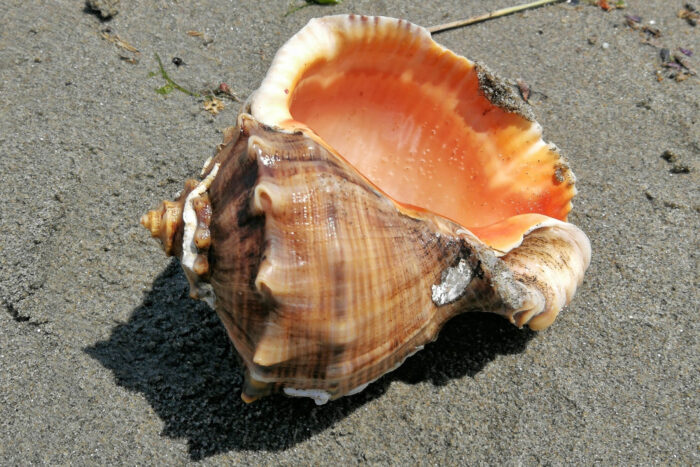Veined rapa whelk
Rapana venosa
The veined rapa whelk is a large, predatory snail that lives in the lower Chesapeake Bay. It is an invasive species.
This section shows one large critter image at a time. Use the thumbnails that follow to select a specific image to display here.

This gallery contains a grid of small thumbnails. Selecting a thumbnail will change the main image in the preceding section.
Appearance
The veined rapa whelk grows to 6 to 7 inches in length. It has a heavy, rounded shell with a short spire and large body whorl. Its shell is almost as wide as it is long, giving it a boxy appearance, and it varies in color from gray to reddish-brown with dark brown dashes on the spiral ribs. Most shells have distinctive black veins throughout. The inside of the shell is deep orange.
Feeding
Rapa whelks prey upon bivalves such as clams, oysters and mussels. They smother prey by wrapping themselves around the hinge of their prey’s shells, then feeding between the opened shells.
Predators
Turtles and other seasonally migrating large predators may prey on young rapa whelks. Once rapa whelks reach their adult size, they likely do not have any predators in the Bay.
Reproduction and life cycle
During warmer months, rapa whelks lay groups of egg cases attached to rocks and other hard surfaces. Rapa whelk egg cases look like small mats of yellow shag carpet. Each egg case is approximately 2 inches tall and one-quarter of an inch thick.
In approximately 18 to 26 days, tiny, free-swimming larvae hatch from a small hole at the top of each egg case. After 4 to 6 weeks, larvae settle to the bottom and eventually grow into hard-shelled adults. Young grow rapidly during their first year and can reproduce by their second year. Rapa whelks can live longer than 10 years.
Did you know?
- The veined rapa whelk is a gastropod, a type of mollusk that includes whelks, snails and slugs. It is also known as the Asian rapa whelk.
- Rapa whelks can tolerate large temperature fluctuations, polluted water and low oxygen levels.
- It was discovered in the Chesapeake Bay in 1998 by a trawl survey group with the Virginia Institute of Marine Science (VIMS).
- Rapa whelks were likely introduced into the Bay through ships that released ballast water containing tiny rapa whelk larvae.
- It’s important to report rapa whelk sightings to VIMS so scientists can track their distribution in the Bay. If you think you have found a veined rapa whelk, call the VIMS Rapa Whelk Reporting Line at (804) 684-7361.
Sources and additional information
- Rapa Whelk Research – Virginia Institute of Marine Science
- Rapana venosa – Global Invasive Species Database
- Nonindigenous Species Information Bulletin: Veined Rapa Whelk – U.S. Geological Survey
